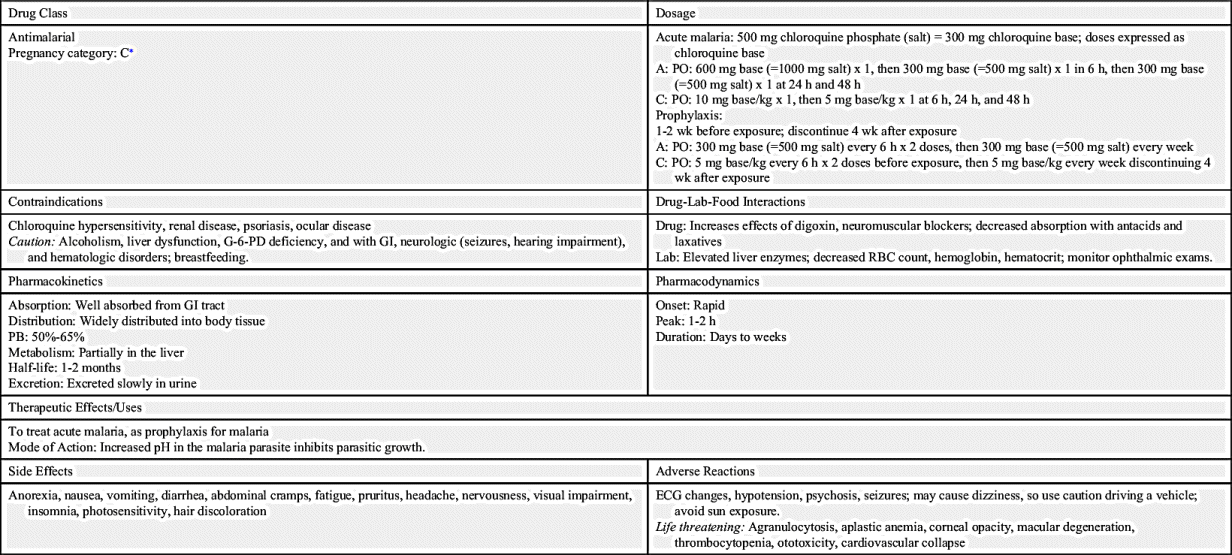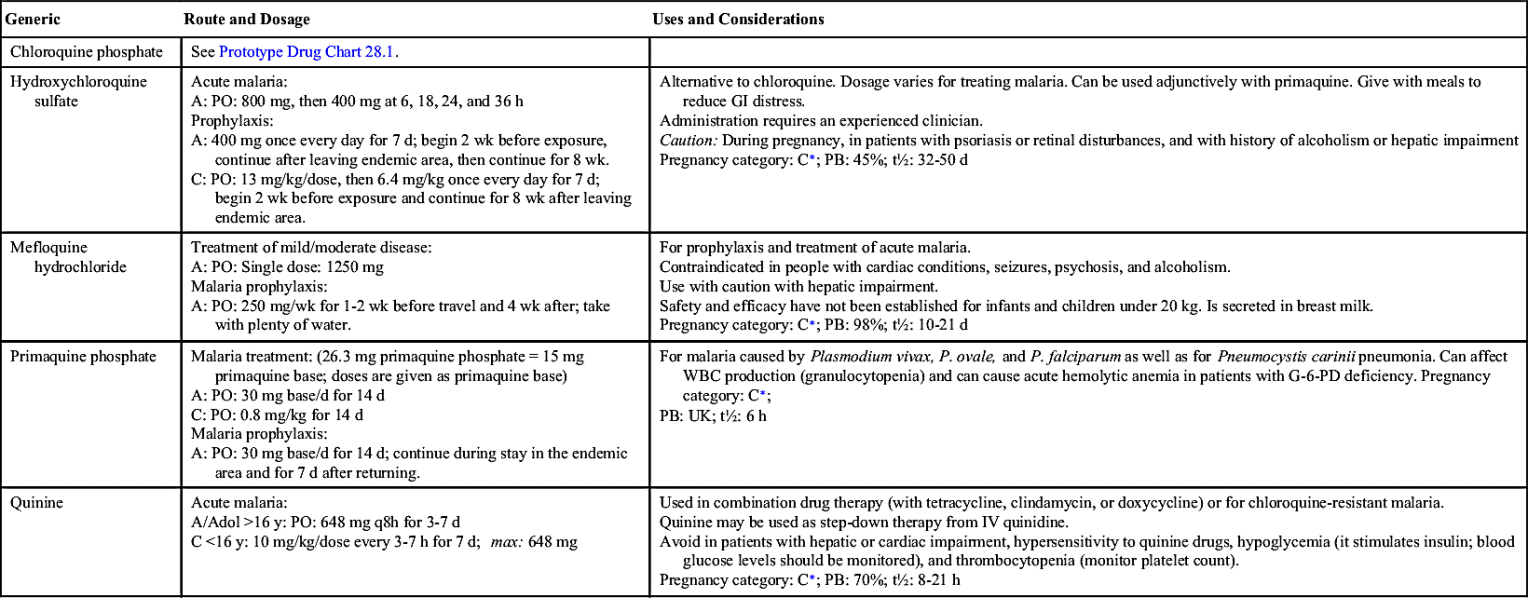http://evolve.elsevier.com/McCuistion/pharmacology/
Antimalarial Drugs
Malaria is a life-threatening disease that was eliminated from the U.S. in the early 1950s. Since that time, 1500 to 2000 cases of malaria have been reported mostly by recent travelers. The World Health Organization (WHO) is an agency of the United Nations with the purpose of monitoring communicable and noncommunicable disease outbreaks globally. WHO reported an estimated 214 million new cases of malaria in 2015. Sub-Saharan Africa has the highest rate, at 88%. Malaria is caused by multiple species of protozoan parasites of the genus Plasmodium that are carried by infected Anopheles mosquitoes, and it remains one of the most prevalent protozoan diseases. After the mosquito infects the human, the protozoan parasite passes through two phases: the tissue phase and the erythrocytic phase. The tissue phase (invasion of body tissue) produces no clinical symptoms in the human, but the erythrocytic phase (invasion of the red blood cells) causes symptoms of chills, fever, and sweating. The incubation period is 10 to 35 days, followed by flulike symptoms. Preventing transmission of malaria can be done by controlling the mosquito firstly through insecticide-treated mosquito nets and secondly with spraying.
There are approximately 50 species of Plasmodium, four of which cause malaria: P. malariae, P. ovale, P. vivax, and P. falciparum. P. vivax is the most prevalent, whereas P. falciparum is the most severe. In spite of having over 200 million cases of malaria globally, in the United States malaria is confined mainly to persons who enter the country after having traveled abroad. The incidence of malaria has increased since 1960, primarily because of travel to regions in the world where malaria is endemic and drug-resistant malaria parasites have evolved.
Treatment of malaria depends on the type of Plasmodium and the organism’s life cycle. Quinine was the only antimalarial drug available from 1820 until the early 1940s. Antimalarial drugs provide treatment and prophylaxis, and synthetic antimalarial drugs have since been developed that are as effective as quinine and cause fewer toxic effects. When drug-resistant malaria occurs, combinations of antimalarials are used to facilitate effective treatment. Chloroquine is a commonly prescribed drug for malaria. If drug resistance to chloroquine occurs, another antimalarial such as mefloquine hydrochloride (HCl) or combinations of antimalarials with or without antibiotics (e.g., tetracycline, doxycycline, clindamycin) may be prescribed.
Three methods used to eradicate malaria are prophylaxis (prevention), treatment for the acute attack, and prevention of relapse. Many synthetic antimalarials, chloroquine and primaquine among them, are used prophylactically. Chloroquine and mefloquine are frequently used to treat an acute malarial attack. Mefloquine HCl and the combination drug atovaquone-proguanil are used to treat chloroquine-resistant P. falciparum. Chloroquine and hydroxychloroquine can be toxic to children and may even cause death, therefore the drug dose should be closely monitored. Prototype Drug Chart 28.1 lists the drug data for chloroquine phosphate.
Pharmacokinetics
Chloroquine phosphate is well absorbed from the gastrointestinal (GI) tract. It is moderately protein binding, and the drug has a long half-life. The first two doses have a loading dose effect. Because of the drug’s long half-life, the next dose is given in 6 hours, the third and fourth doses are given at 24 and 48 hours. Chloroquine is metabolized in the liver to active metabolites and is excreted in the urine. Antimalarial drugs concentrate first in the liver; if the patient drinks large amounts of alcohol or has a liver disorder, the liver enzymes will require closer monitoring. Renal impairment may also occur as an adverse effect of antimalarials.
Pharmacodynamics
Chloroquine phosphate inhibits the malaria parasite’s growth by interfering with its protein synthesis. Whether the drug is given orally or intramuscularly (IM), the onset of action is rapid. The peak effect is slower when given orally. The duration of effect of the drug is very long, from days to weeks.
Side Effects and Adverse Reactions
General side effects and adverse reactions to antimalarials include GI upset, cranial nerve VIII involvement (quinine and chloroquine), renal impairment (quinine), and cardiovascular effects (quinine).
Table 28.1 lists commonly ordered antimalarial drugs and their dosage, uses, and considerations. Note that quinine is an antimalarial drug, and quinidine is an antidysrhythmic drug. A medication guideline developed by the U.S. Food and Drug Administration (FDA) accompanies mefloquine each time it is dispensed. This type of guideline is used only for drugs that require monitoring for serious adverse effects. Adverse effects of mefloquine include severe anxiety, restlessness, disorientation, depression, hallucinations, paranoia, and suicidal thoughts, which may continue after the drug is discontinued.
Anthelmintic Drugs
Helminths are large parasitic worms that live and lay eggs in warm, moist soil where sanitation and hygiene are poor (Centers for Disease Control and Prevention [CDC], 2013). Transmission occurs from infected soil to the person, whereupon the helminth then feeds on host tissue. The most common site for helminthiasis (worm infection) is the intestine. Other sites for parasitic infection are the lymphatic system, blood vessels, and liver. These parasites cause disability and developmental delays in children and adolescents.
Groups of helminths include (1) cestodes (tapeworms), (2) trematodes (flukes), (3) intestinal nematodes (roundworms), and (4) tissue-invading nematodes (tissue roundworms and filariae). They enter the human host via contaminated food, bites of carrier insects, or direct penetration of the skin. The cestodes (tapeworms) are segmented and enter the intestine via contaminated food. There are four species of cestodes: Taenia solium (pork tapeworm), T. saginata (beef tapeworm), Diphyllobothrium latum (fish tapeworm), and Hymenolepis nana (dwarf tapeworm). The segmented cestodes have heads and hooks or suckers that attach to the tissue.
Stay updated, free articles. Join our Telegram channel

Full access? Get Clinical Tree











